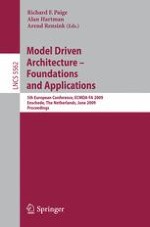The ?fth edition of the European Conference on Model-Driven Architecture Foundations and Applications (ECMDA-FA 2009) was dedicated to furthering the state of knowledge and fostering the industrialization of Model-Driven - chitecture (MDA) and Model-Driven Engineering (MDE). MDA is an initiative proposed by the Object Management Group for platform-generic systems - velopment; MDA is one of a class of approaches under the umbrella of MDE. MDE and MDA promote the use of models in the speci?cation, design, analysis, synthesis, deployment, and evolution of complex software systems. It is a pleasure to be able to introduce the proceedings of ECMDA-FA 2009. ECMDA-FA 2009 addressed various MDA areas including model transfor- tions, modelling language issues, modelling of behavior and time, traceability and scalability, model-basedembedded systems engineering,and the application of model-driven development to IT and networking systems. ECMDA-FA 2009 focused on engaging key European and international - searchers and practitioners in a dialogue which will result in a stronger, more e?cientindustry,producingmorereliablesoftwareonthebasisofstate-of-the-art research results. ECMDA-FA is a forum for exchanging information, discussing the latest results and arguing about future developments of MDA and MDE. Particularly, it is one of the few venues that engages both leading academic researchers and industry practitioners, with the intent of creating synergies.
